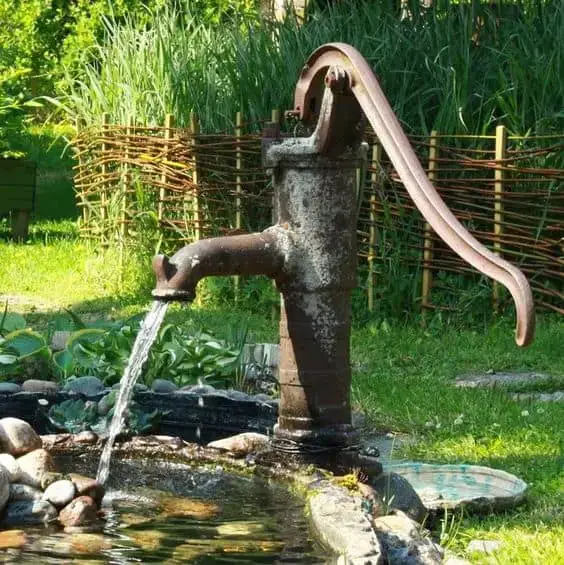31+ Different Types Of Aloe Plants With Pictures (Identification Guide)
While many people are familiar with the majestic leaves and health benefits of aloe plants, few are aware of the vast array of species that exist. Native to North Africa, there are at least 250 distinct types of aloe plants, each with its unique characteristics. In this article, we’ll delve into not only the most common types of aloe but also explore some notable FAQs about the plant, its benefits, and more.
From the African aloe to the Soap Aloe, we’ve listed 31 different species of aloe plants that you might find interesting. Whether you’re an avid gardener or simply looking to learn more about these incredible plants, this article is for you. So, let’s dive in and explore the wonderful world of aloe plants.
Some of the notable types of aloe plants include the African aloe, Aloe Albiflora, Aloe Principis, Aloe vera (Aloe barbadensis), Arabian Aloe, Barbados Aloe, Cape Aloe, Clanwilliam Aloe, Climbing Aloe, Coral Aloe, Fan Aloe, Gold Toothed Aloe, Grass Aloe, Kimberley’s Rock Aloe, Lace Aloe, Malagasy Tree Aloe, Mountain Aloe, Prickly aloe, Rat Aloe, Red Aloe, Sand Aloe, Short Leaf Aloe, Snake Aloe, Soap Aloe, Spiral Aloe, Sunset Aloe, Tiger Tooth Aloe, Tilt-Head Aloe, Torch Aloe, and Tree Aloe.
But aloe plants aren’t the only succulents that might be mistaken for them. Agave, Gasteria, and Haworthia are just a few examples of plants that can be easily confused with aloes. If you’re looking to learn more about these unique plants or how to care for your own aloe vera plant, we’ve also got some valuable growing tips and benefits.
So, what’s the takeaway from all this?
Aloe plants are incredibly diverse, and there’s much more to them than just their majestic leaves and health benefits. With so many different species out there, it’s no wonder that people get excited about these amazing plants.
How do I identify my Aloe plant?
Aloe plants are frequently confused with hawthorn, gasteria, and agave species. To distinguish aloe from its lookalikes, one must focus on the characteristic shape and texture of their leaves. This distinctive feature sets them apart. Aloe leaves typically exhibit a triangular shape and an unusually fleshy consistency. In comparison to agave and hawthorn, aloes tend to be smaller in stature (though some varieties can grow quite tall).
Another notable identifier is the plant’s spikes, which can range from soft and gentle to sharp and potentially painful. The snap test provides a conclusive confirmation that a plant is indeed an aloe rather than an agave. When you break the leaf of an aloe, it will release a copious amount of sticky substance, which is often extracted for use in herbal supplements, cosmetics, shampoos, and soaps. In contrast, agaves lack this distinctive gel.
Types of aloe plants
While aloe plants generally prosper in full sun and partial shade, it’s crucial to note that there’s an incredible diversity among species. With over 580 known varieties worldwide, identifying the best-suited options can be overwhelming. To provide a solid starting point, here are some of the most common types of aloe plants worth getting familiar with.
African aloe (Aloe africana)
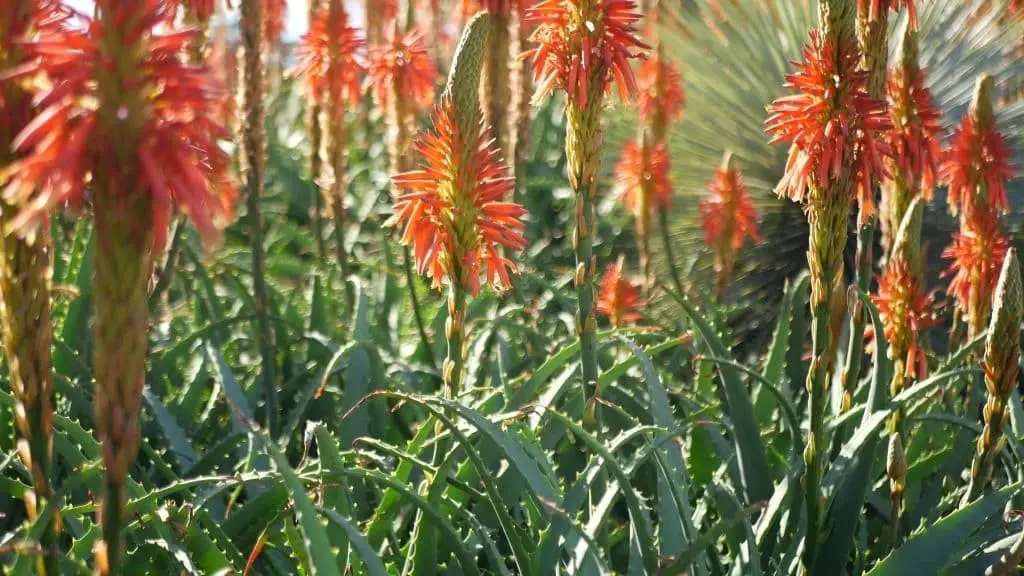
One of the rarest single-headed South African aloe varieties, this unique species boasts drooping leaves sprouting directly from its trunk. Drought-tolerant by nature, it can grow up to 8 feet in height and spread out to 4 feet in width. The plant’s striking feature is its vibrant orange and yellow flowers that bloom throughout the spring and winter seasons. Interestingly, it requires little to no watering and can thrive in temperatures as low as 25 degrees Fahrenheit.
Aloe Albiflora
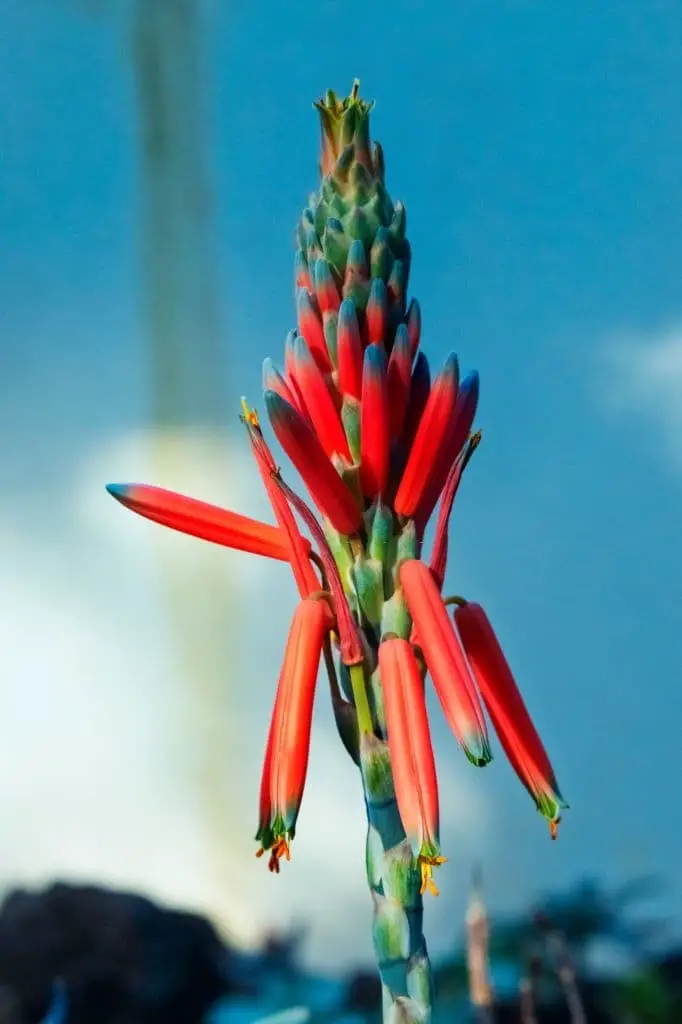
The dwarf aloe in question boasts an uncommon appearance, characterized by elongated leaves with a striking gray-green hue and distinctive white speckles stretching along their length. While it may resemble some Madagascar aloes at first glance, its most defining feature is the delicate, lily-like blooms that emerge during early summer, setting it apart from its counterparts.
Aloe Principis
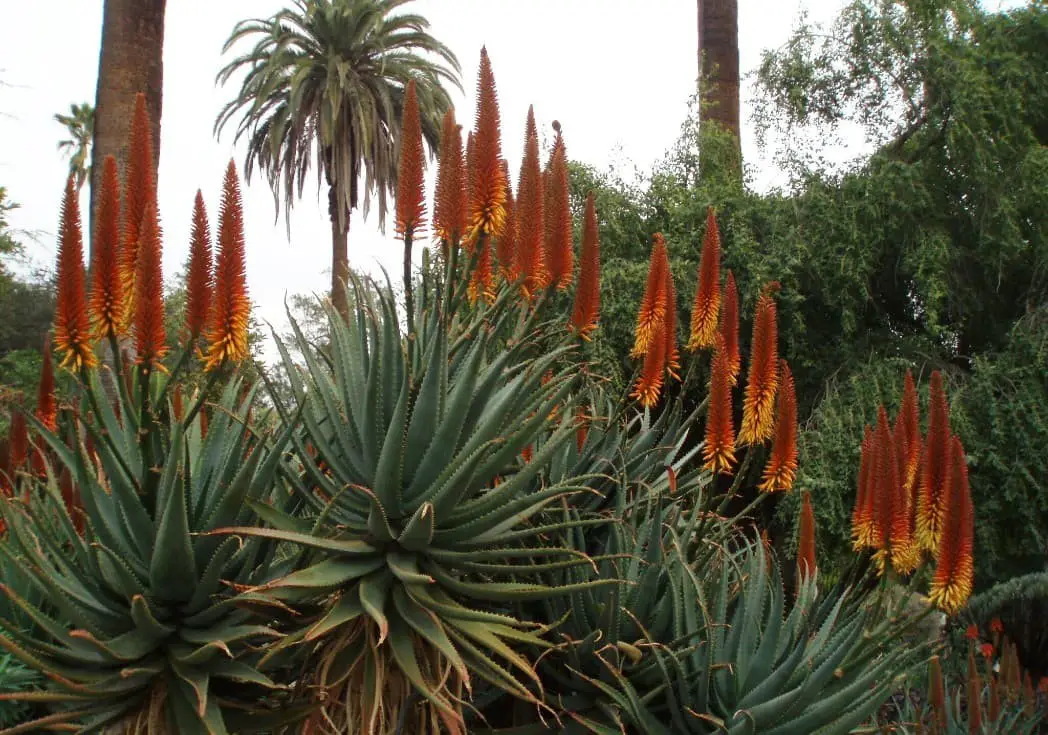
Another stunning aloe species that thrives as an accent plant in winter gardens is notable for its striking red-orange spires that emerge during the colder months. This architectural feature adds visual interest to Mediterranean-style succulent gardens, where it can often be found. What’s more, this aloe variety is a magnet for pollinators like bees, butterflies, and hummingbirds, making it an excellent choice for gardeners seeking to attract wildlife.
Aloe vera (Aloe barbadensis)
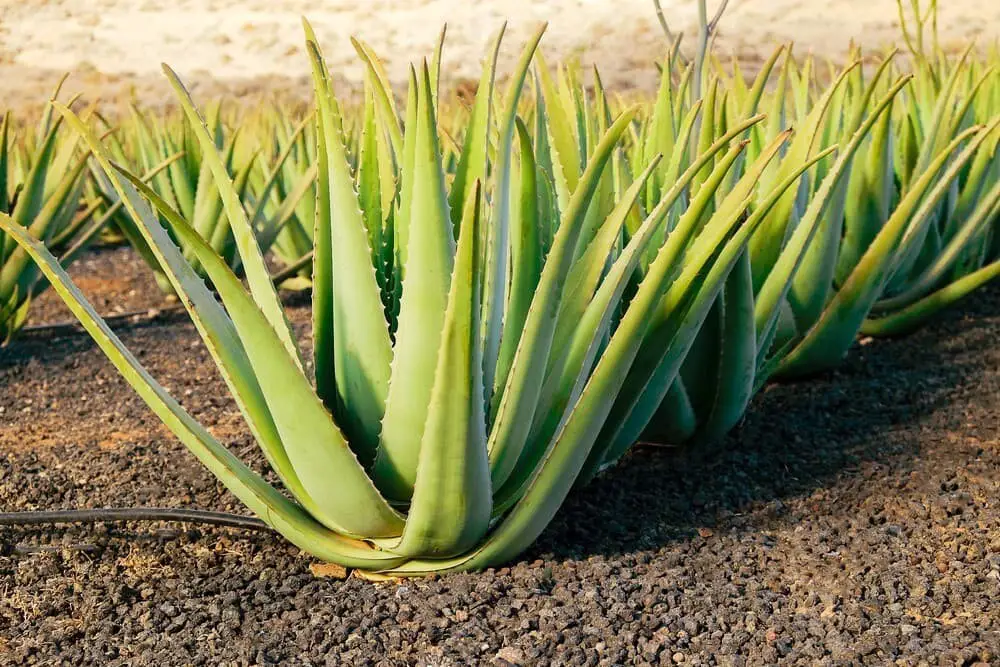
One of the most renowned aloe plants is revered for its comprehensive medicinal properties, which have led to widespread adoption across various industries. The plant’s gel has been extracted and utilized in an array of products, including food supplements, skin care regimens, shampoos, and pharmaceuticals.
This versatility stems from the plant’s impressive antioxidant and anti-inflammatory profiles, making it a valuable solution for addressing a diverse range of health concerns, such as wound healing, scar treatment, digestive issues, and even cancer.
Arabian Aloe (Aloe rubroviolacea)
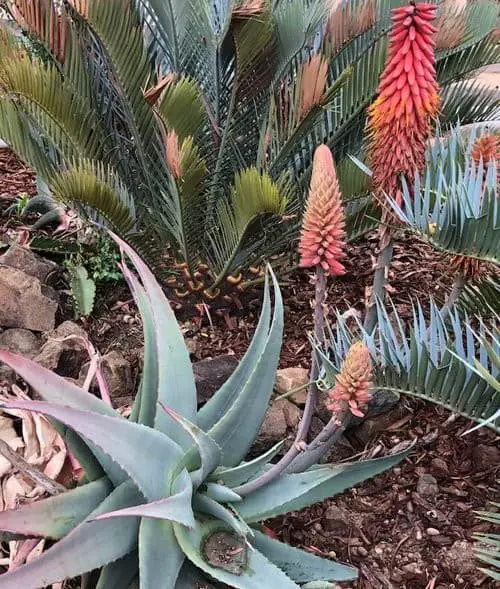
This compact aloe variety thrives in large groups, boasting remarkable resilience to drought. Its value lies in its low-maintenance requirements, making it an ideal choice for garden beds, as well as containers on decks, patios, and indoor spaces. The plant’s striking blue-green leaves feature subtle red edging, which deepens to a rich purple hue when exposed to direct sunlight.
Notably, this aloe variety is disease-resistant and produces vibrant red flowers in abundance during the winter months.
Barbados Aloe (Aloe barbadensis)

The most sought-after aloe species is renowned for its well-documented therapeutic capabilities. This versatile plant is commonly found in local herbariums, where it’s harvested for its gel and utilized in treating various hair, skin, and wound-related issues. Interestingly, the plant produces vibrant yellow flowers during its youth, but this ability diminishes as it matures.
Cape Aloe (Aloe Ferox)
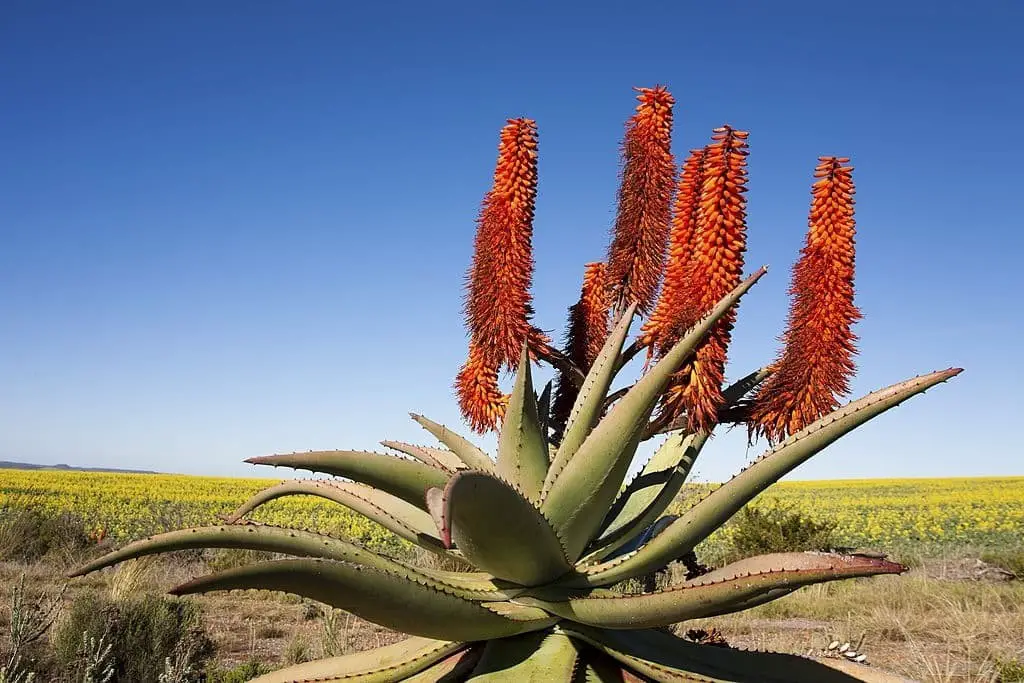
The Cape Aloe, native to desert environments, boasts impressive characteristics. Its leaves are adorned with spines and rows of teeth that run along their length. The plant’s striking feature is its vibrant red or orange flowers that grow upright, creating a dramatic display. Like the Barbados Aloe, the gel extracted from the plant is highly valued for its use in food supplements and skin care products.
Clanwilliam Aloe (Aloe comosa)
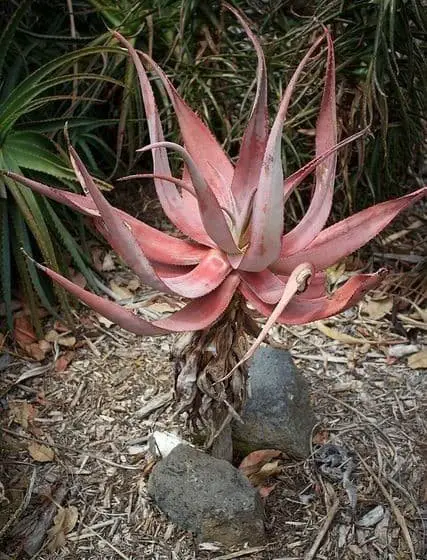
A majestic tree aloe variety, this species can grow to heights of at least three meters, its solitary trunk giving rise to a striking display of dry, leafy fronds that evoke a bearded appearance. The leaves themselves feature reddish-brown thorns, while the plant bursts into bloom with bright yellow flowers throughout the summer months.
Climbing Aloe (Aloe Ciliaris)
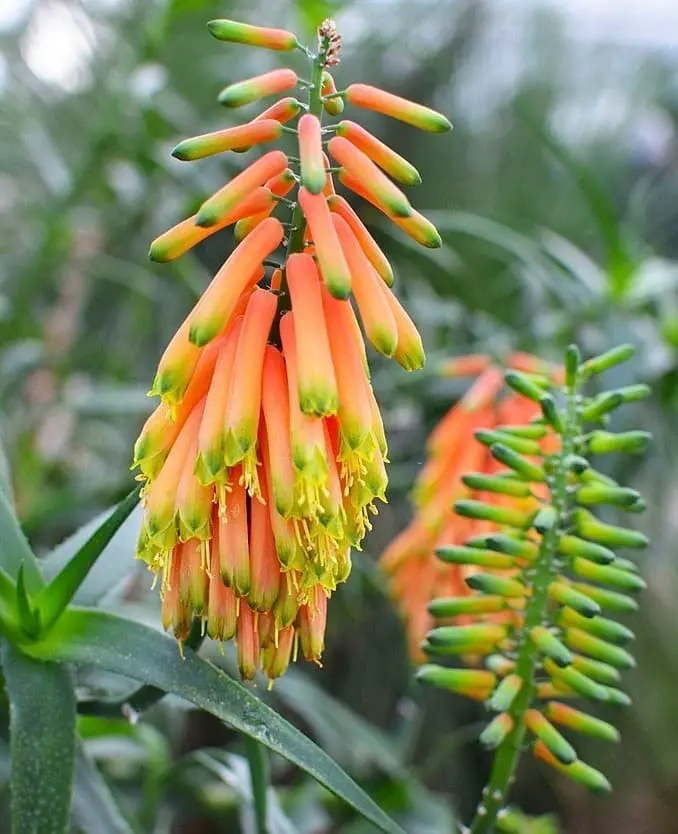
The Aloe’s slender yet robust nature makes it a popular choice among garden enthusiasts. Its striking appearance, characterized by tube-shaped flowers with a vibrant red-orange hue and yellow tips, adds significant ornamental value to any landscape. Moreover, the plant’s colorful display attracts a variety of pollinators, including butterflies, bees, and hummingbirds, making it a valuable asset for attracting wildlife.
Coral Aloe (Aloe Striata)
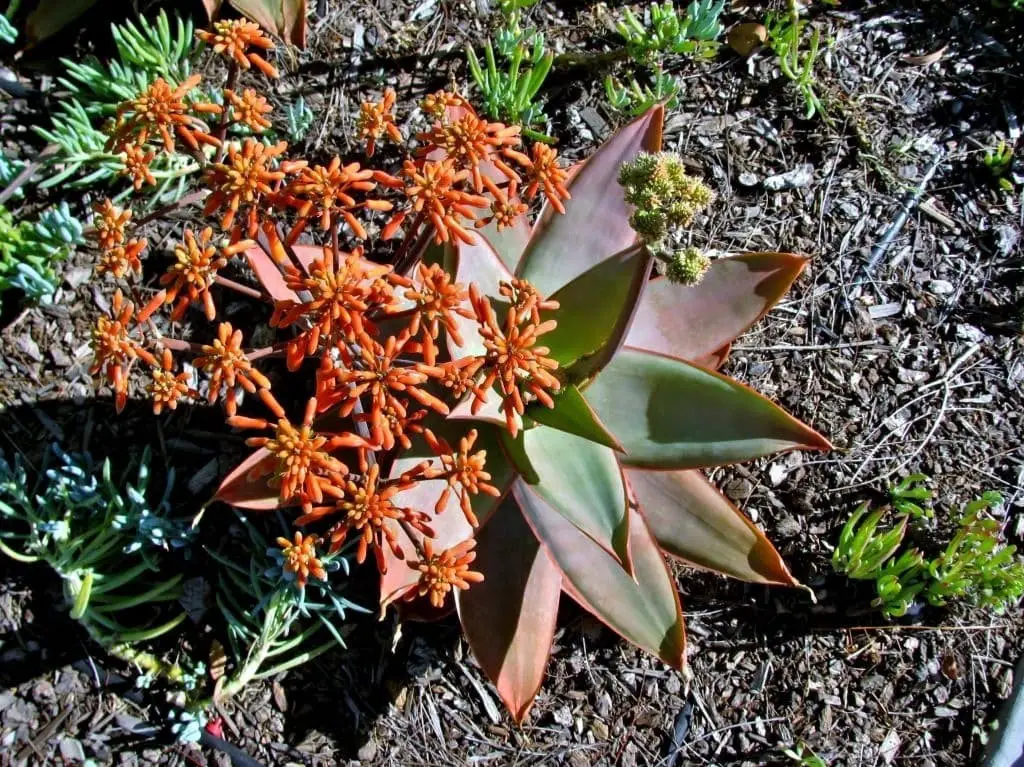
This majestic tree aloe can stretch up to 18 feet in height and width, boasting broad and flat leaves with a unique grayish-green hue. As it basks in full sun, the leaves transform into a vibrant pink, while in partial shade, they take on a stunning purplish-blue tone.
The tree’s common name stems from its striking coral-colored flowers that bloom from winter to spring, adding a pop of color to any landscape.
While it can be used as a border or accent plant, the tree aloe is particularly well-suited for container gardens, where its beauty and low-maintenance requirements can truly shine.
Fan Aloe (Aloe Plicatilis)
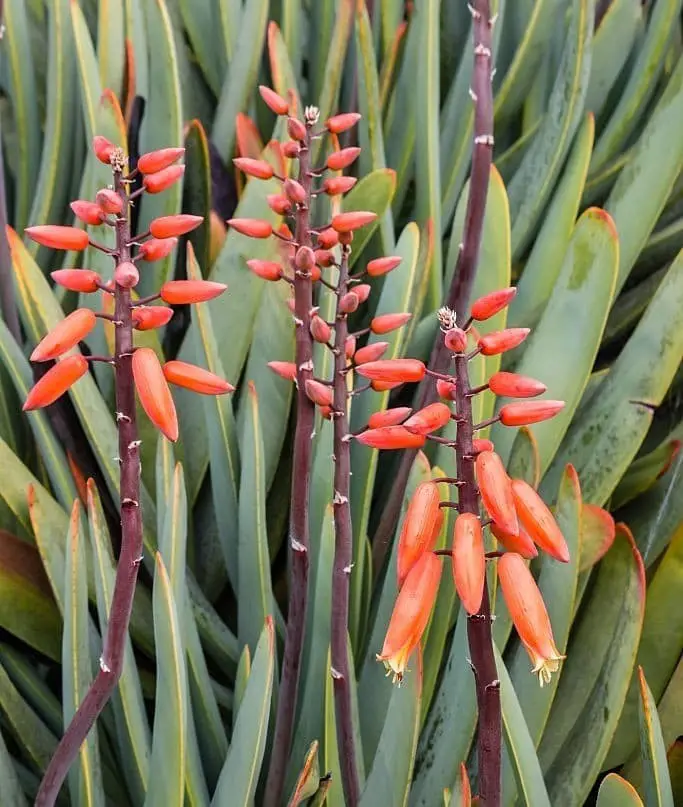
The Aloe aristata, also known as the Long-Leaved Aloe, gets its name from its unique, fan-like foliage. During winter or spring, this succulent plant truly shines with its striking blue-grey leaves featuring vibrant orange tips. Additionally, it boasts bright red-orange flowers that add to its visual appeal. This award-winning aloe has earned recognition for its remarkable disease and deer resistance, making it an excellent choice for gardeners looking for low-maintenance, resilient specimens.
Gold Toothed Aloe (Aloe Nobilis)
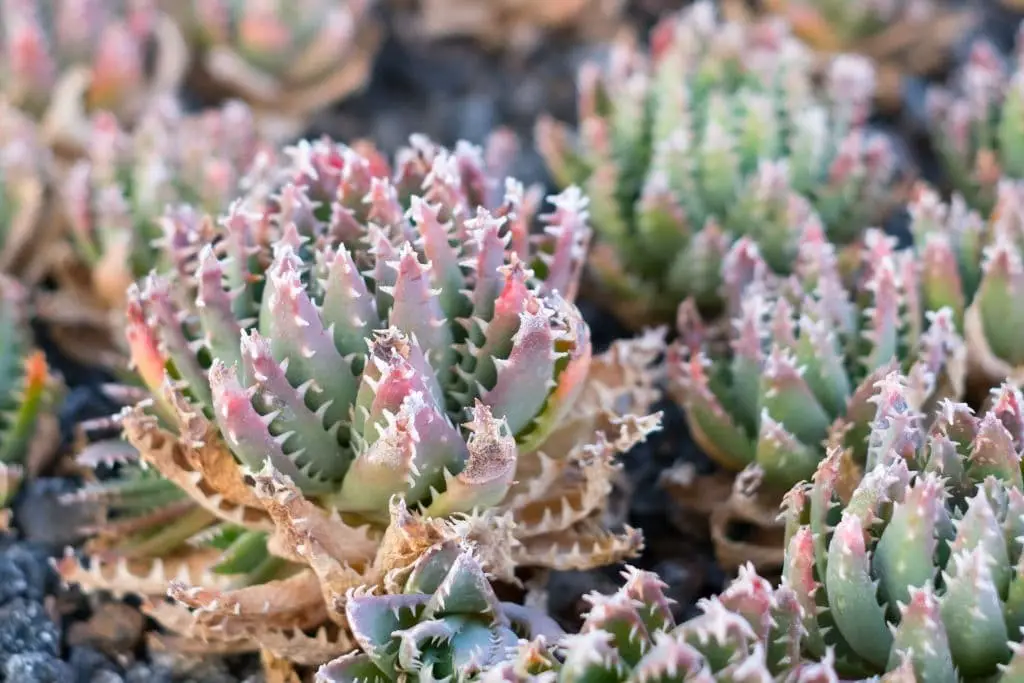
This exceptional aloe variety truly stands out from the crowd. Its striking rose-tipped leaves and bright yellow spikes are a unique combination that’s hard to ignore. As they mature, these leaves form a rosette that bursts forth with vibrant red-orange flowers, perfect for adding a pop of color to your winter garden or succulent arrangement. Thriving in full sun, this aloe variety can grow up to 12 inches tall and is sure to be a stunning addition to any outdoor space.
Grass Aloe (Aloe albida)
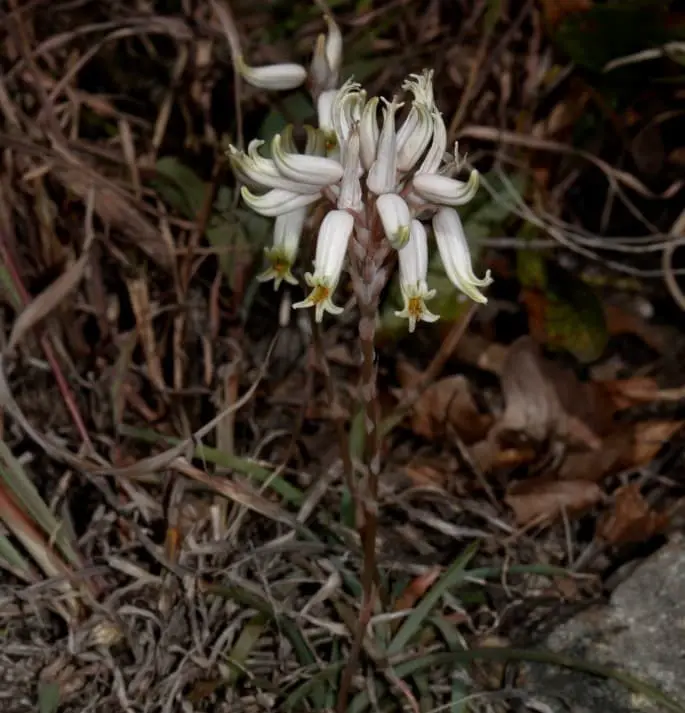
In the rugged terrain of grassy mountains, a diminutive aloe plant flourishes, its leaves peeking out from beneath moss-covered rocks and often obscured by lush blades of grass. As its name suggests, this enigmatic succulent’s foliage maintains the characteristic rosette shape, boasting a subtle gray-green or blue-green hue. The waxy texture of its leaves is another distinguishing feature.
When late spring gives way to mid-spring, delicate white flowers burst forth, adding a touch of elegance to the plant’s understated demeanor. Interestingly, this aloe species thrives in conditions with more shade than direct sunlight.
Kimberley’s Rock Aloe (Aloe inyangensis)
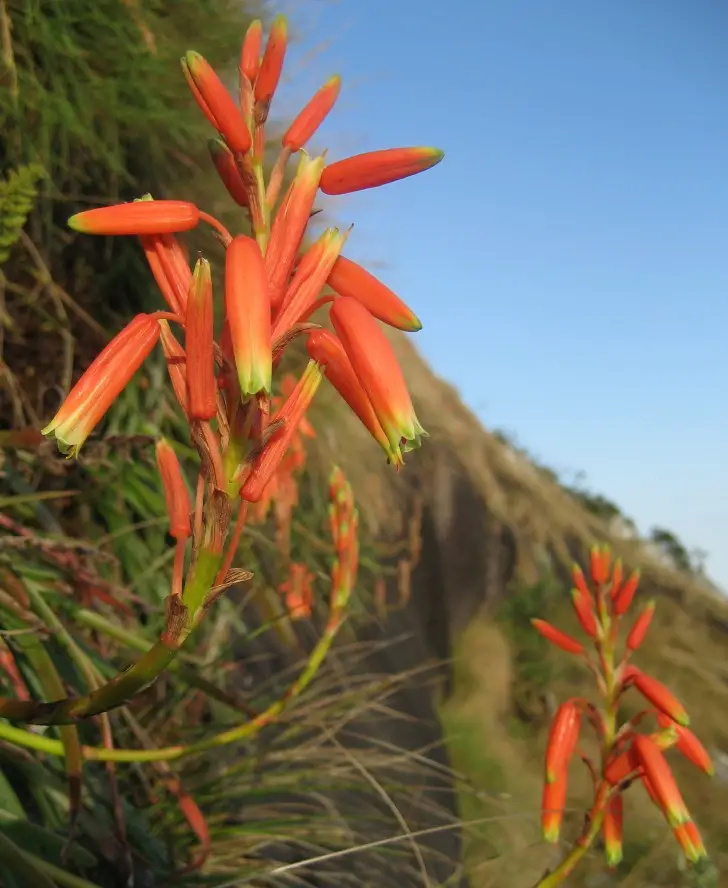
Another distinctive species of aloe features strap-shaped leaves that curve forward from their central vein. The foliage is a striking scarlet color, setting this plant apart from others in its genus. When it blooms, it produces small white or yellow flowers, which appear throughout the year, making it a year-round bloomer.
Lace Aloe (Aloe Aristata)
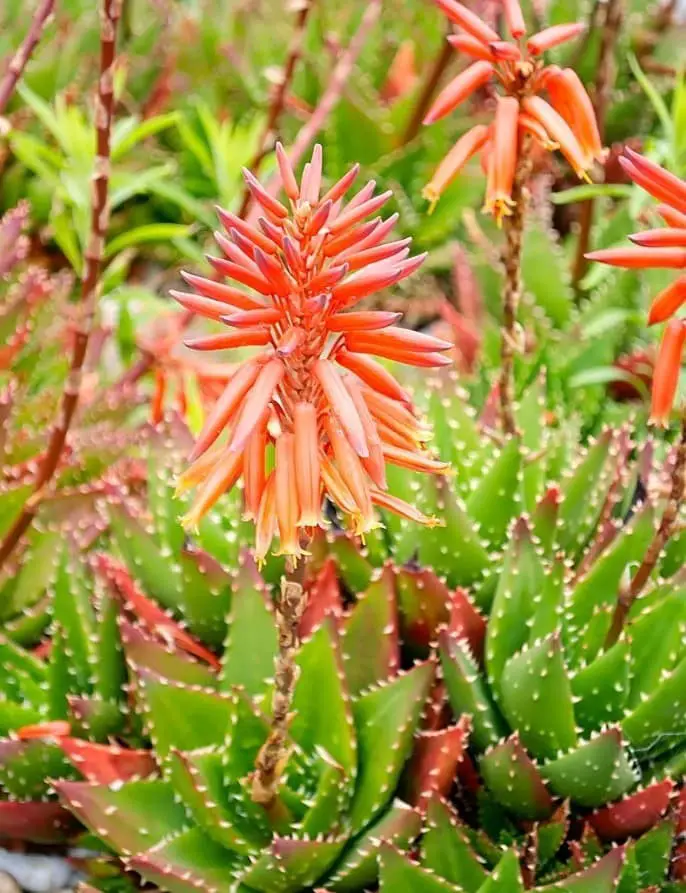
This particular aloe species thrives in shaded conditions, exhibiting an impressive ability to withstand temperatures near freezing. Its striking resemblance to the hawthorn plant is largely due to the presence of white bristles that cover its surface. Characterized by its spherical shape and dark green leaves, this cold-climate aloe is native to South Africa and can grow up to 9 inches in height.
Malagasy Tree Aloe (Aloe Vaombe)
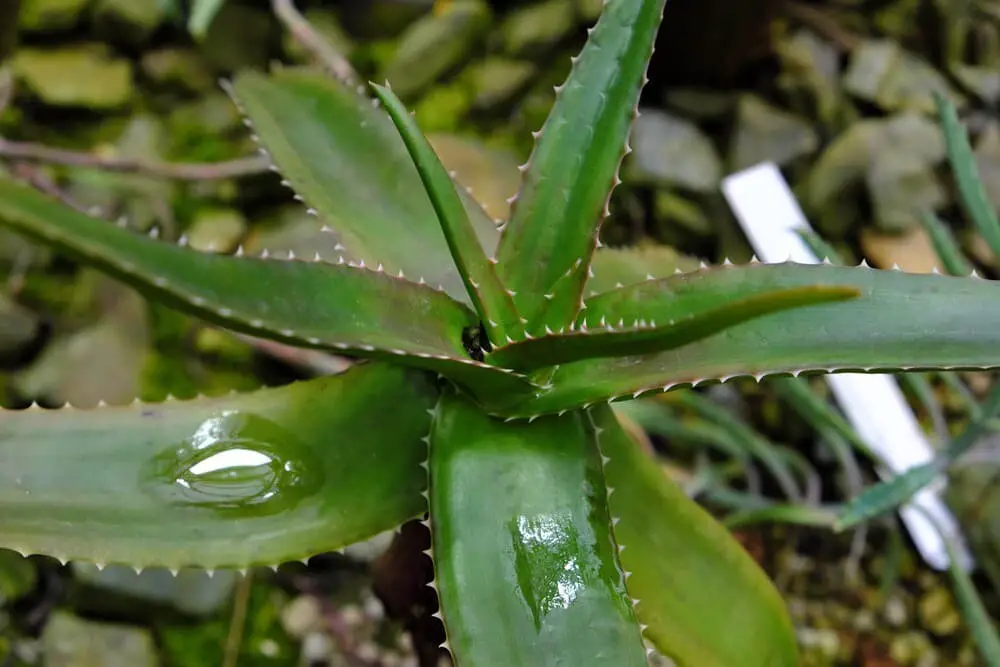
The Aloe tree stands out due to its peculiar tree-like form, diverging from the typical rosette shape found in most aloe plants. Its origin story is equally fascinating – hailing from the Malagasy region of Madagascar, it has successfully adapted to and thrived in various regions, including Arizona and New Zealand. A key feature of this unique species are its sturdy, drooping leaves, which bear toothed edges that add to their distinctiveness.
As the seasons change, these remarkable plants burst forth with long stalks bearing vibrant red flowers, attracting a range of pollinators such as hummingbirds and butterflies in the spring.
Mountain Aloe (Aloe Marlothii)
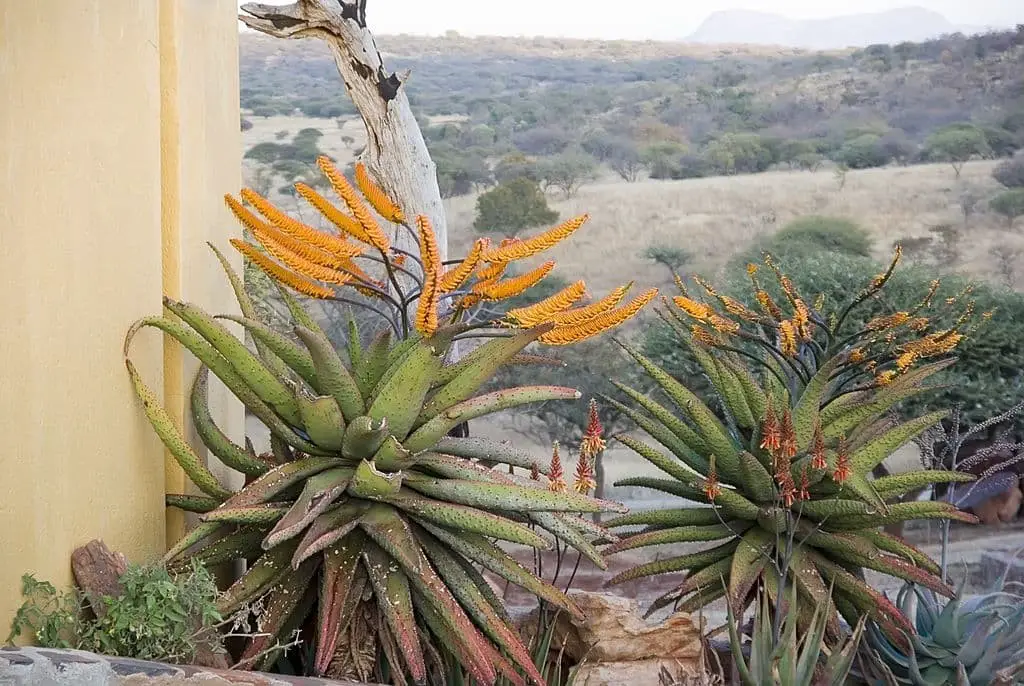
One variety of aloe that excels in arid environments is characterized by its striking resemblance to palm trees. While its stems are surrounded by leaves with a palm-like appearance, the spines on these leaves serve as a distinguishing feature. This unique aloe thrives in dry conditions and produces dense clusters of bright yellow and red flowers during the winter months, making it an eye-catching addition to any garden.
Prickly aloe (Aloe aculeata)
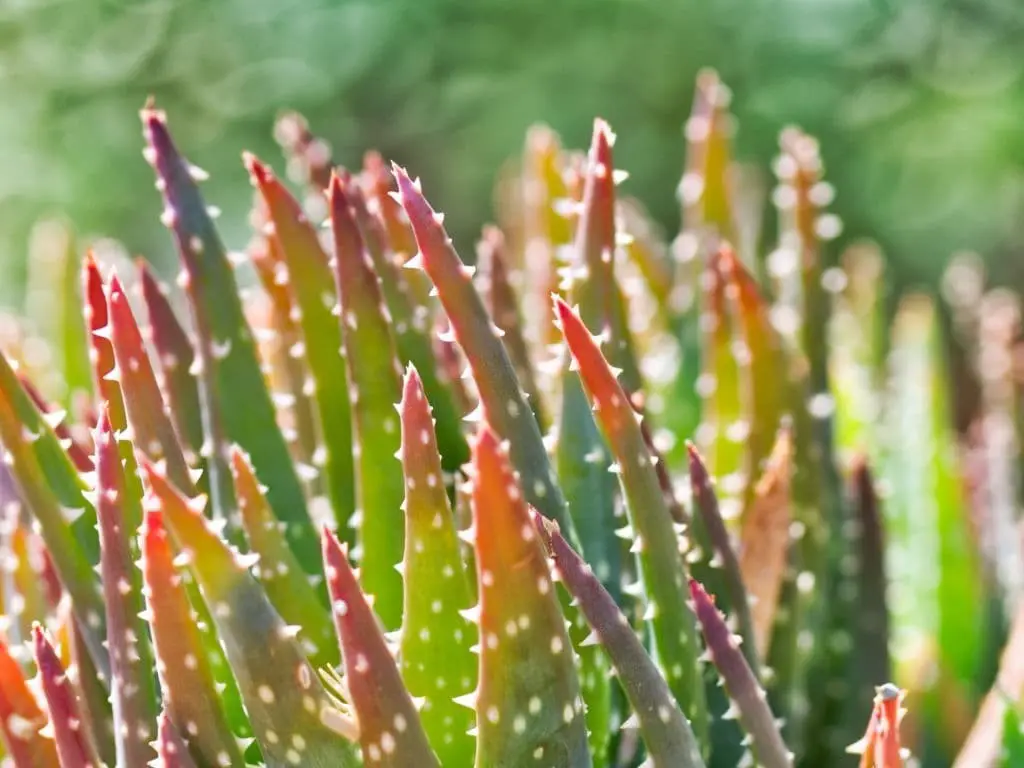
The standout feature of this aloe plant is its unique tuber-like base from which sprout the spines that set it apart from other aloe varieties. Measuring up to 2 feet in length, the leaves themselves are quite substantial, and when combined with the overall height of the plant, reaching a maximum of 4 feet, make for an impressive display.
But what truly sets this plant apart is its winter flowering habit, where masses of vibrant pink blooms burst forth, making it a stunning addition to both raised beds and indoor containers alike.
Rat Aloe (Aloe ballyi)
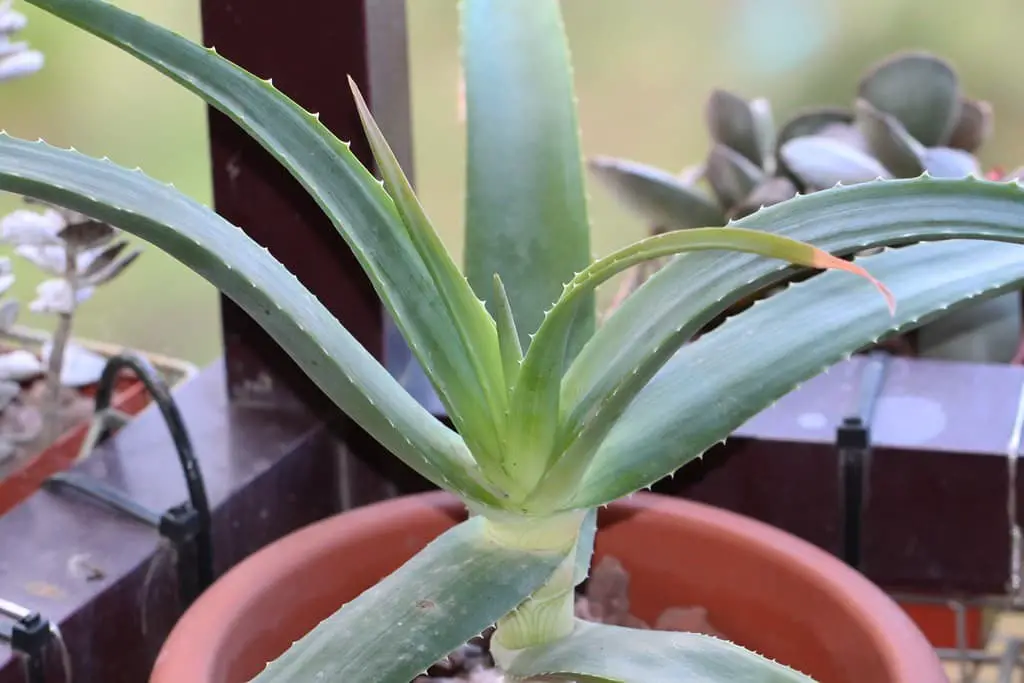
One of the few aloe species classified as toxic is also notorious for its pungent aroma, which is often likened to the smell of rodents. This plant, despite its potential medicinal benefits as a laxative, has been linked to adverse reactions such as upset bowels, asthma, and triggered allergies when used as a home remedy. It can grow up to 8 feet tall and is already recognized as poisonous in many African regions, where it is native.
Red Aloe (Aloe Cameronii)

The aloe vera species with the most striking appearance is one that derives its name from its distinctive copper-red leaves. This rare plant has adapted to thrive in arid and drought-prone environments, making it surprisingly sensitive to overwatering. A peculiar aspect of this aloe is its color-changing ability; when exposed to excessive moisture, its leaves turn green, while during dry spells, they regain their vibrant red hue.
Native to South Africa, this compact plant grows up to 24 inches tall and produces showy daisy-hibiscus-like flowers in the summer months.
Sand Aloe (Aloe hereroensis)
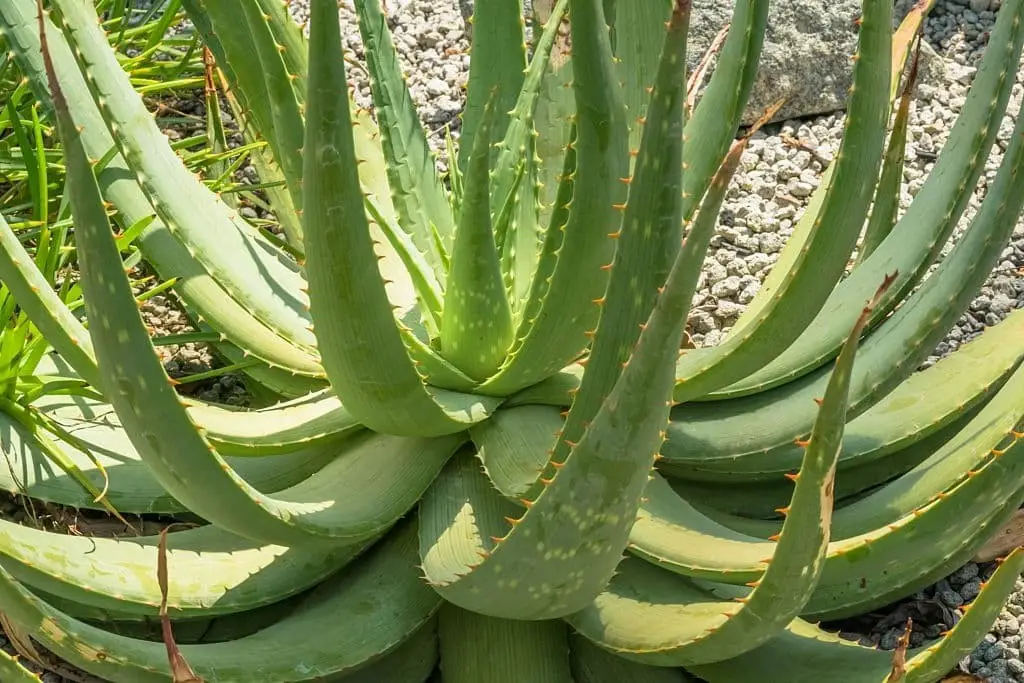
The Chameleon Aloe, as its name suggests, exhibits an extraordinary ability to adapt its leaf color in response to varying levels of sunlight. As the leaves absorb more radiant energy, they transform from silvery green to pale green, and under shadier conditions, they take on a subtle pinkish hue. A notable characteristic of this species is its robust spination, featuring sharp, tooth-like appendages that demand caution when handling.
It’s essential to don gloves while tending to the Chameleon Aloe to avoid any potential discomfort. Additionally, this hardy succulent can withstand temperatures above 25°C, making it a resilient addition to any garden or indoor setting.
Short Leaf Aloe (Aloe Brevifolia)
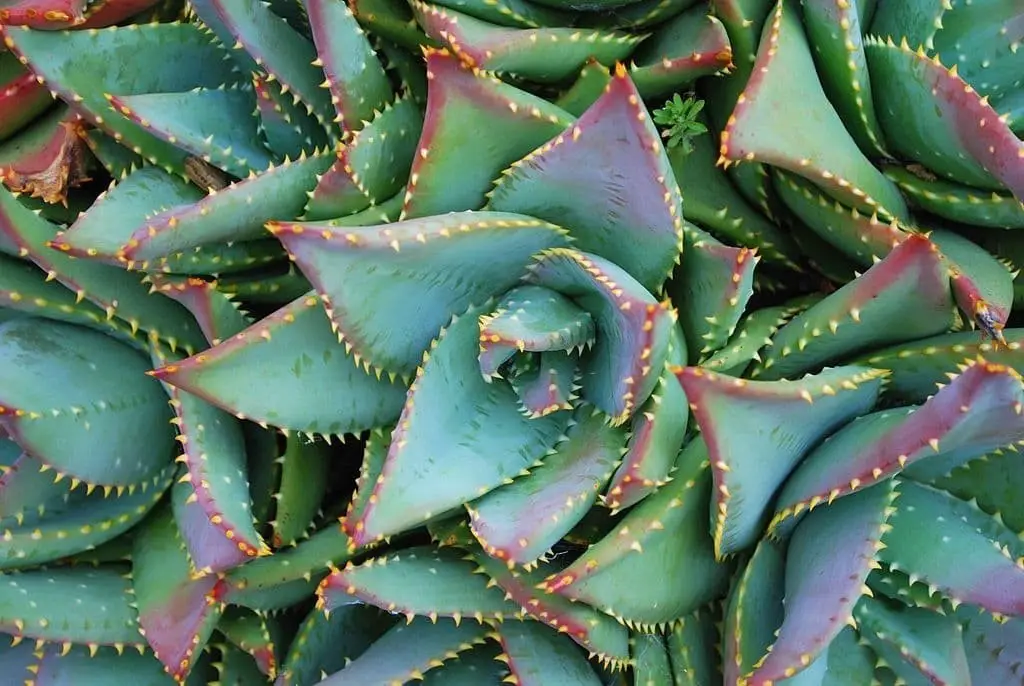
For gardeners living in regions where temperatures rarely drop below 25C, Aloe vera is an excellent choice for adding a pop of color and texture to your outdoor space. One of its most attractive features is its exceptional drought tolerance, making it an ideal selection for water-conscious gardeners. Reaching a maximum height of just 4 inches, this compact aloe is perfect for creating a lush ground cover that requires minimal maintenance.
Its unique, grey-green leaves are adorned with vibrant orange streaks, adding visual interest to your garden bed. In the fall and winter seasons, Aloe vera produces bright orange flowers that will add a warm, inviting touch to your outdoor space.
Snake Aloe (Aloe broomii)
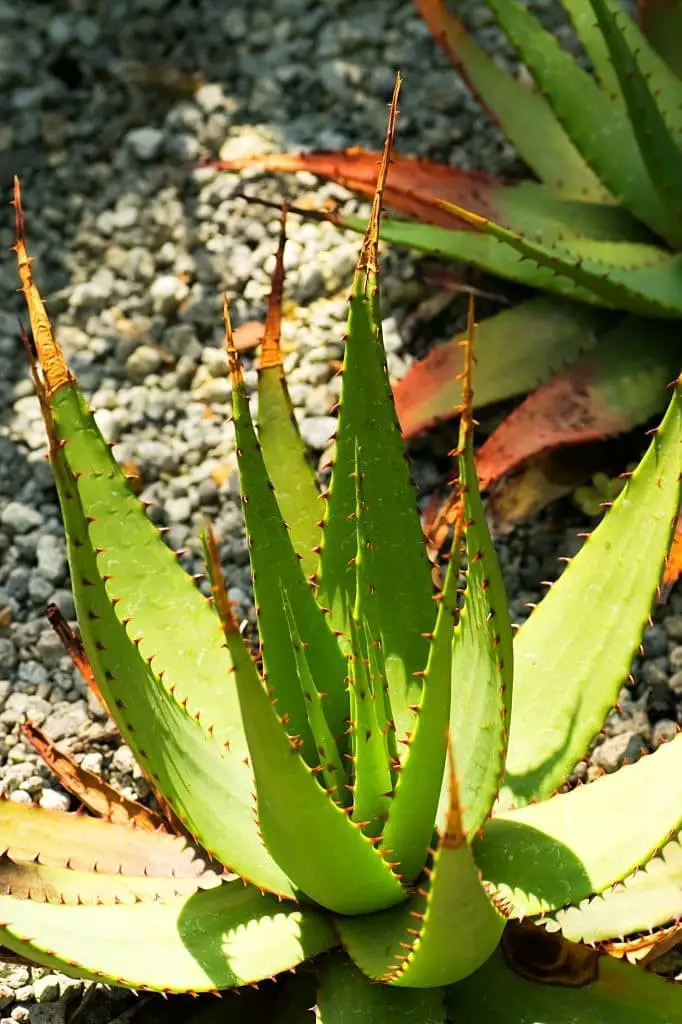
The Aeonium is a unique succulent that’s not just recognized by its striking leaves. While they’re indeed serpentine and toothed, it’s the stiff and spiky texture that sets them apart. But it’s the flowers that truly make this plant stand out – small, globular blooms that are unlike anything else in the botanical world. As a drought-tolerant species, Aeoniums thrive in warm, dry environments, earning them another nickname: mountain aloe.
With mature plants reaching up to 36 inches tall, they can be used as a sturdy border plant in a summer garden, providing a striking contrast to other foliage.
Soap Aloe (Aloe Maculata)
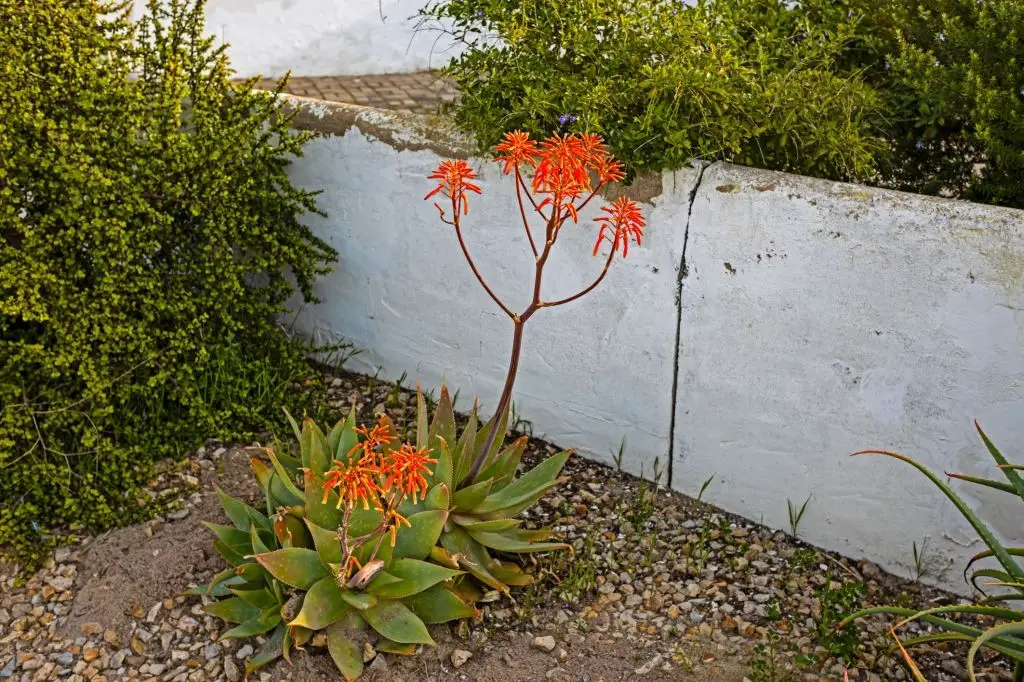
In the Western Cape of South Africa, one can find a unique species of Aloe that boasts vibrant red flowers. This succulent is renowned for its spiky exterior, rivaling the prickliness of cacti. Despite this formidable appearance, it’s surprisingly resilient and can thrive in neglect. Its gel is extracted to produce soap, earning it its distinctive name.
Characterized by slow growth, these aloes don’t require pruning or cutting.
In fact, excessive leaf removal can lead to a disordered, chaotic appearance. It’s best to leave them be, allowing their natural beauty to flourish.
Spiral Aloe (Aloe Polyphylla)
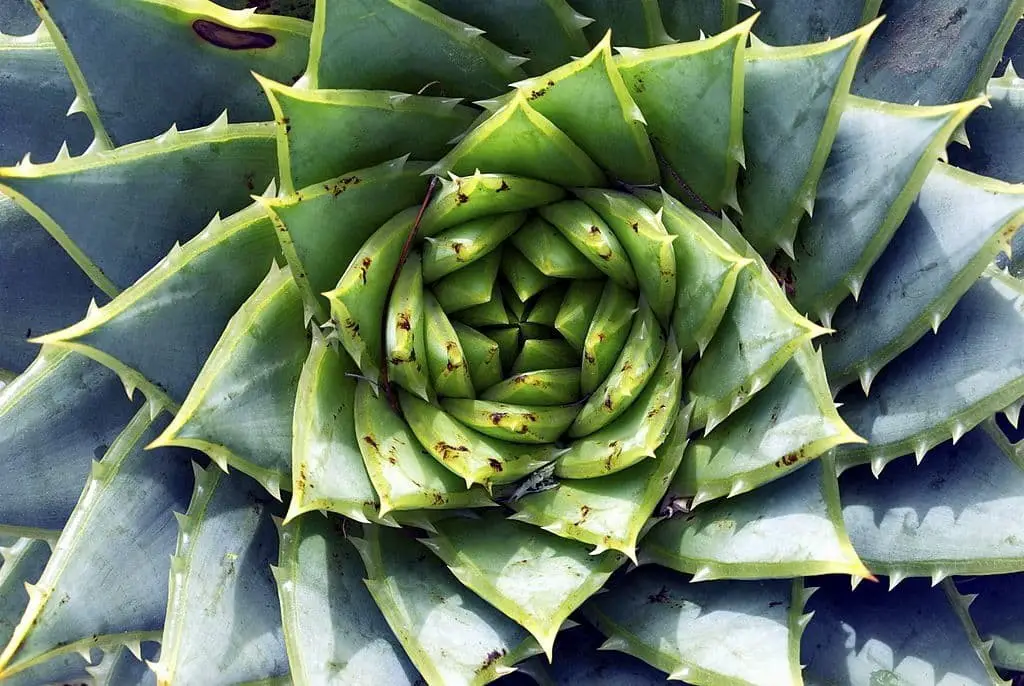
This striking aloe variety boasts a unique spiral shape, departing from the typical rosette form. Measuring around 1-2 feet across and reaching a maximum height of just 1 foot, it’s a compact yet eye-catching addition to any garden. The vibrant green leaves are infused with subtle hints of yellow, creating a visually appealing display that can seamlessly integrate into various garden settings.
Sunset Aloe (Aloe Dorotheae)
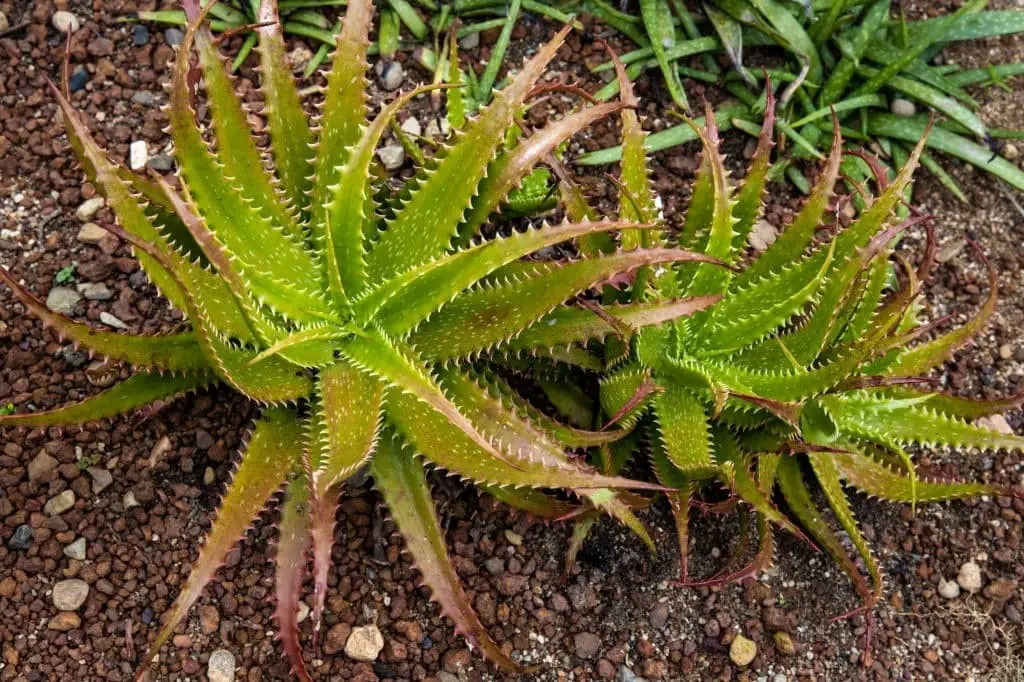
This unique aloe cultivar is recognized by its breathtaking orange and salmon hued leaves, making it an ideal choice for adding a pop of color to rock gardens or as a striking accent piece for patios and decks. As the seasons change, this plant rewards with vibrant, orange flowers featuring subtle greenish tips during the winter months, growing up to 12 inches in height.
Although its beauty is undeniable, it’s worth noting that this species has been listed as endangered in South Africa, emphasizing the importance of conservation efforts for these rare and remarkable plants.
Tiger Tooth Aloe (Aloe Juvenna)
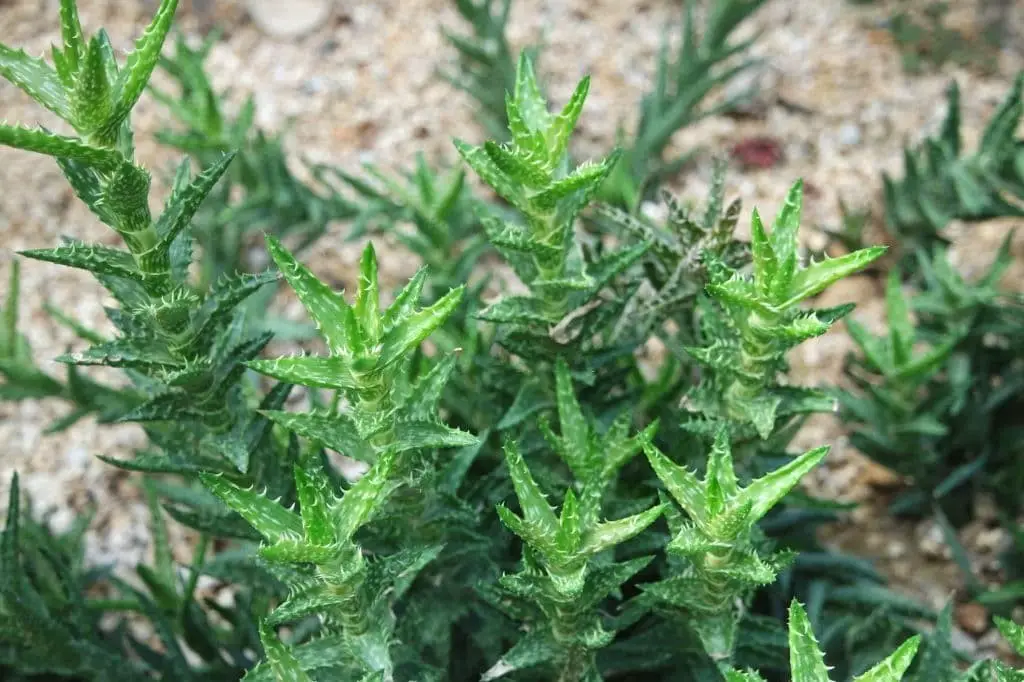
This succulent’s unique appearance is characterized by its toothed protrusions and soft spikes. It excels in partial to full shade, but can also be grown in warmer climates with temperatures above 19°C. Propagation occurs through offsets, which allows for easy multiplication of the plant. When placed in full sun, the bright green foliage takes on a reddish-brown hue, adding a striking pop of color to any garden.
Tilt-Head Aloe (Aloe speciosa)
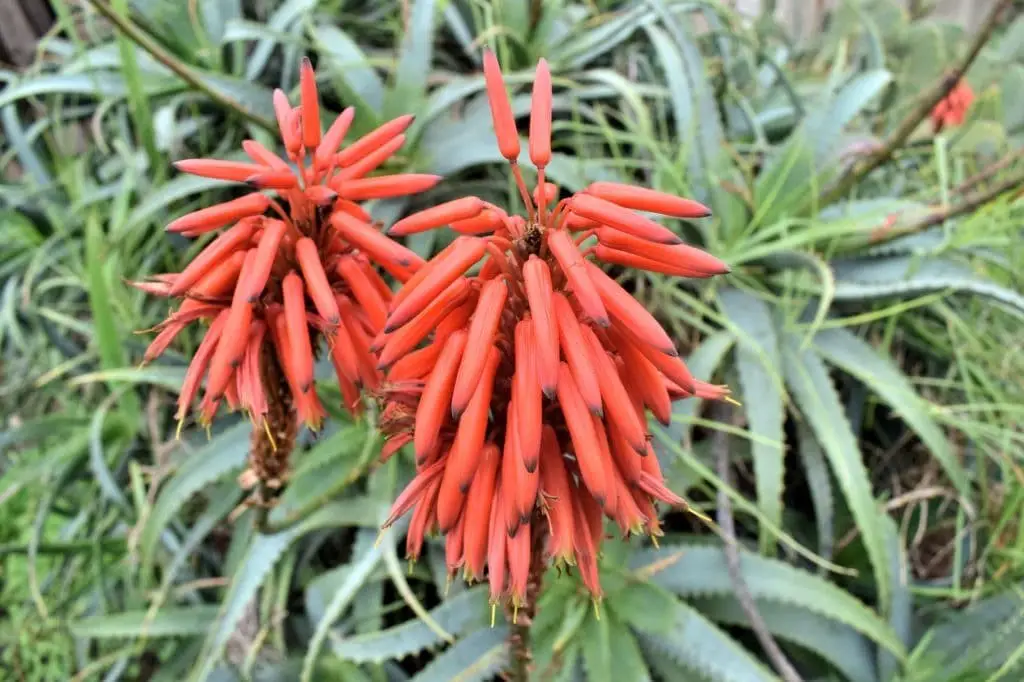
This striking aloe species boasts blue-green leaves with vibrant pink tips, while its large, spiky foliage can reach lengths of up to three feet. Notably, the spikes themselves exhibit a kaleidoscope of colors, transitioning from deep red to cream, yellow, and finally, brownish-red. When mature, this plant can grow to an impressive height of 10 feet, making it a haven for hummingbirds, which are particularly drawn to its nectar-rich blooms.
Torch Aloe (Aloe Arborescens)
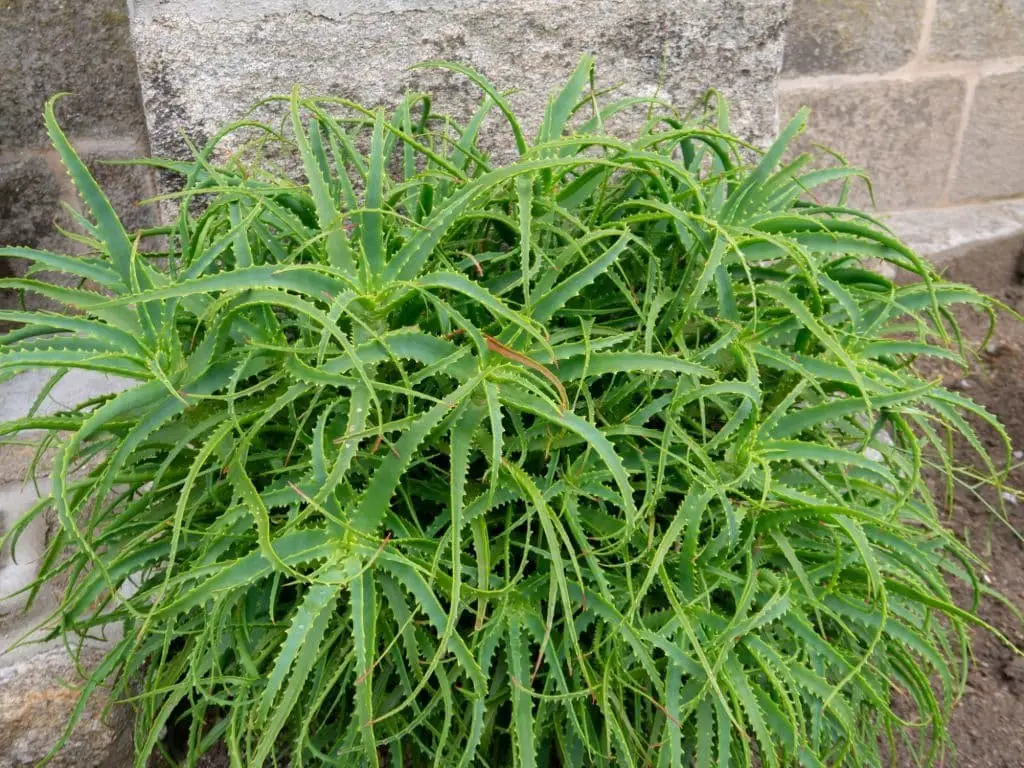
The Krantz Aloe, another ornamental aloe worth knowing, boasts sword-shaped leaves with spikes that take on a vibrant red-orange hue during the winter months. This versatile succulent also produces stunning multicolored blooms in both spring and winter. With a shrubby habit reaching 10 feet in height and width, it excels as an accent, border, or container plant, offering year-round visual interest.
Tree Aloe (Aloe Barberae)
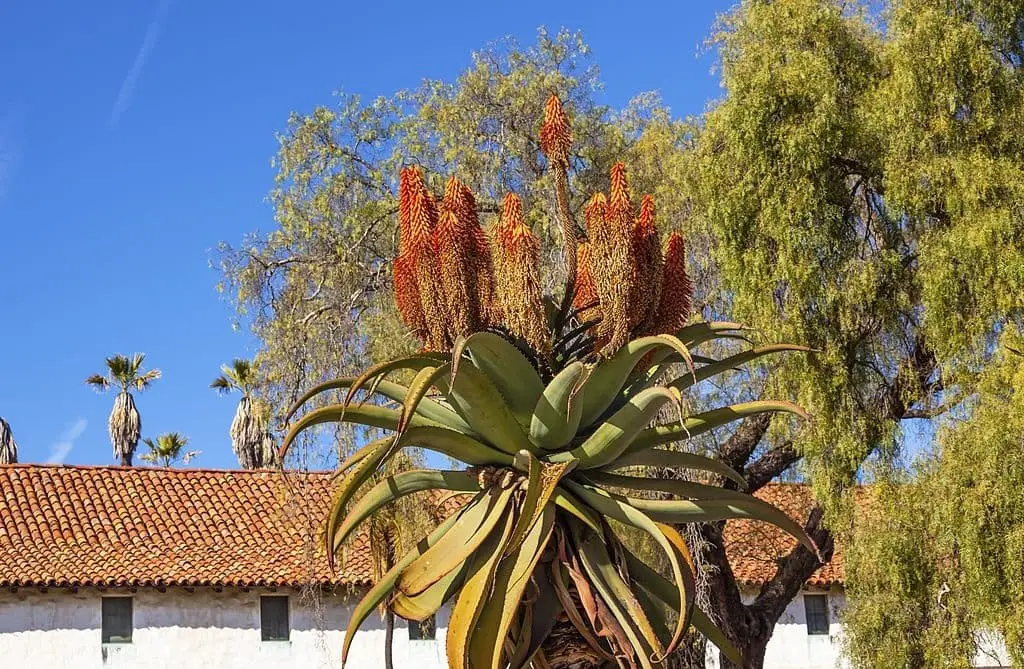
For gardeners seeking a striking specimen tree for pool sides or gardens, the tree aloe is an excellent option. This towering plant can grow up to 30 feet tall, featuring dense, drooping rosettes of leaves and vibrant pinkish-red flowers that bloom during the winter months. Native to South Africa, tree aloes thrive in warmer climates, making them a perfect choice for gardeners in regions with mild winters.
Van Balen’s Aloe (Aloe vanbalenii)
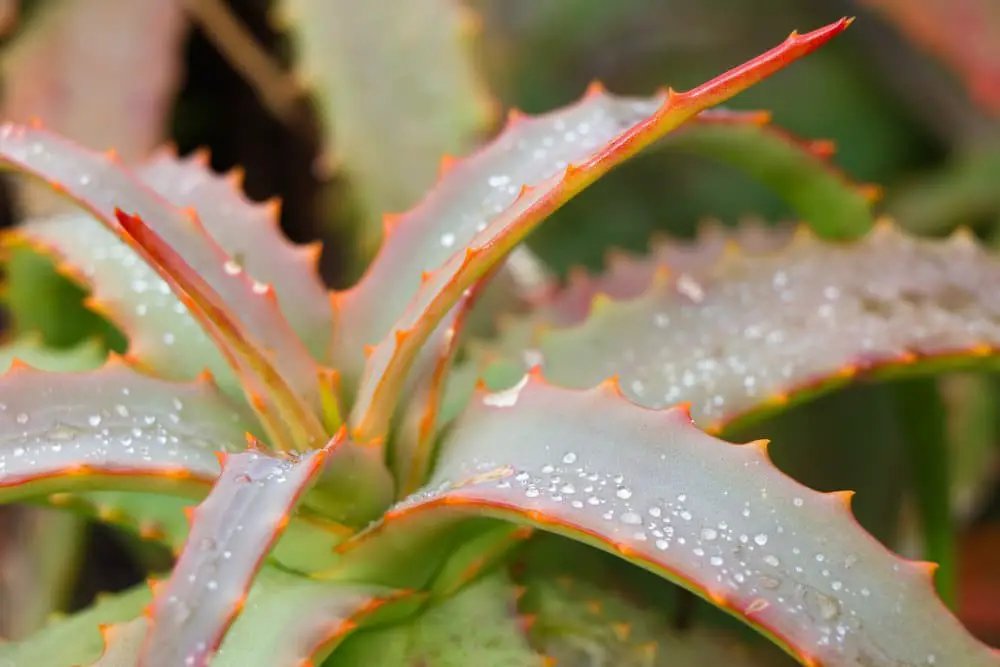
This standout aloe plant boasts an octopus-like appearance, with its sinuous leaf structure resembling tentacles. What’s more, it exhibits a remarkable ability to transform into a vibrant red hue when exposed to intense sunlight. However, the most striking feature of this species is its pungent aroma that emerges when the leaves are crushed. While often found in controlled environments like conservatories, these plants also thrive as landscape additions.
Plants that look like aloes but aren’t
While aloe vera is unique in its own right, it’s not the only plant with similar characteristics. In fact, there are several notable lookalikes that share striking similarities. At the top of the list are agave, gasteria, and haworthia plants, which all bear uncanny resemblance to the beloved aloe vera.
Agave
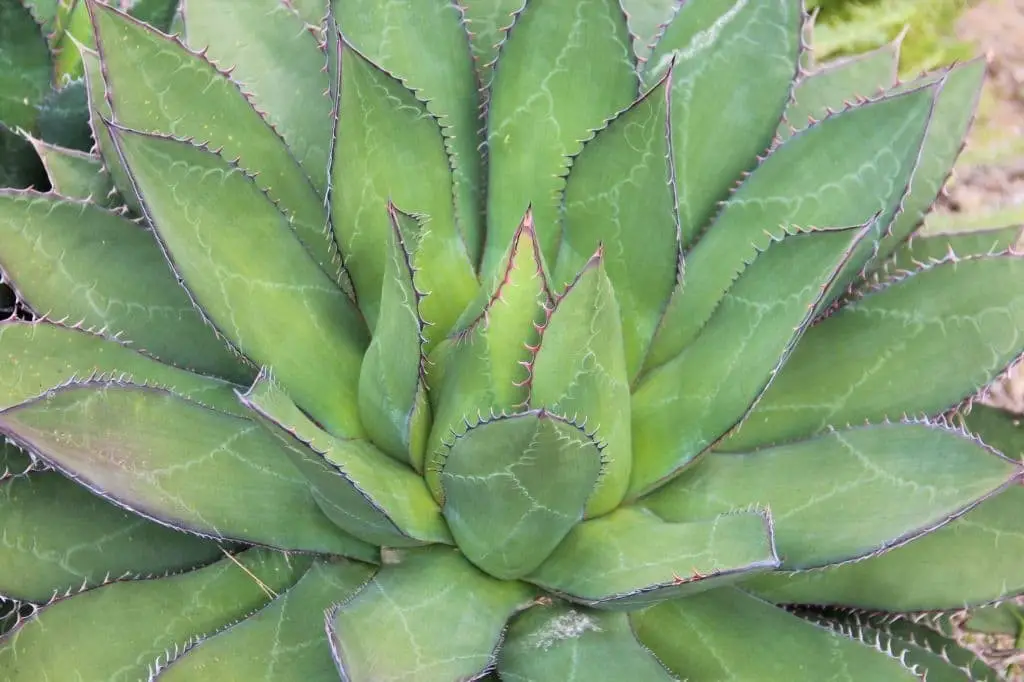
While aloe vera’s triangular leaves may be familiar, the similarities don’t stop there. A type of cactus that shares this leaf shape is actually much larger than its aloe counterpart. Unlike aloes, these plants’ leaves have a fibrous interior rather than containing a gel substance. Additionally, the leaf base yields minimal nectar when snapped off, whereas the apex of the leaf is where you’ll find a sharper, more prominent feature – long, pointed spikes.
Gasteria

This succulent’s striking resemblance to aloe stems from its thick, fleshy leaves. However, it’s distinguished by several key characteristics: rounded leaves adorned with white speckles on the surface and white stripes along their edges. What sets it apart further is the absence of leaf spikes, which are a hallmark of many other succulent species.
Haworthia
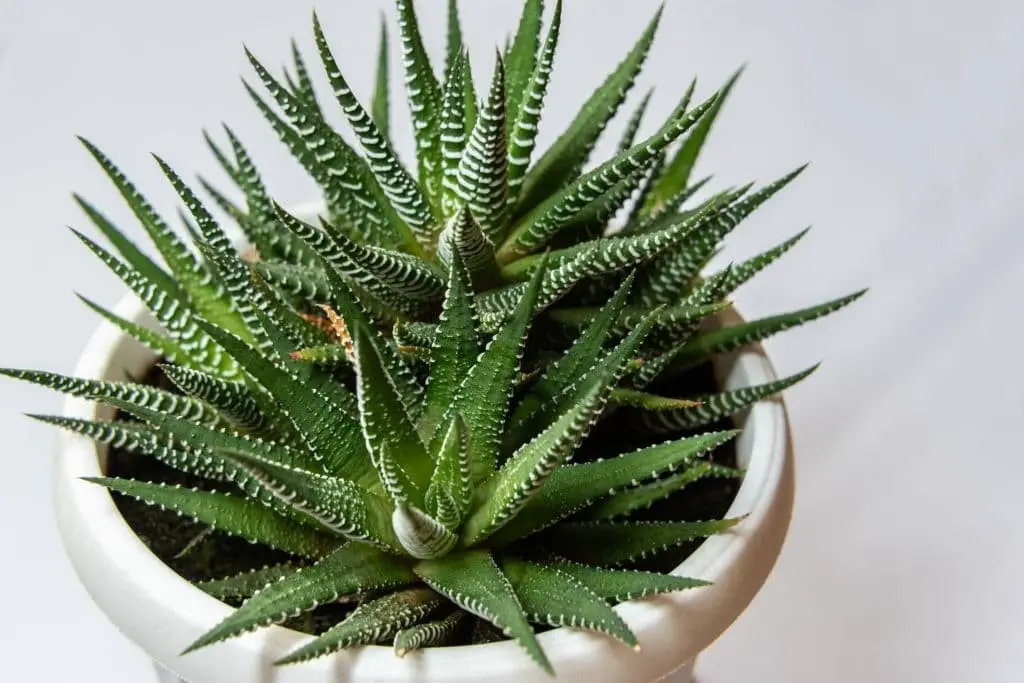
The SucculentBox shop features the Echeveria succulent, which is often misidentified as an Aloe due to its small size even at maturity. However, aside from their rosette shape and long, lance-shaped leaves, there are no other similarities between the two. What truly sets this succulent apart is its smooth surface, making it easily distinguishable from both Aloes and Agaves.
Aloe Vera Growing Tips
Aloe vera benefits
While its widespread popularity is no coincidence, aloe vera stands out from other aloe plants due to its versatile uses in organic food supplements, herbal medicines, and personal care products such as shampoo, soap, skin creams, and cosmetics. Its numerous benefits have solidified its reputation as the go-to aloe plant for many applications.
Digestive cleansing
Aloe vera’s laxative properties are attributed to its aloin content, which contains anthraquinone – a compound that plays a crucial role in regulating bowel movements and metabolism. This unique characteristic makes it an effective treatment for chronic bowel conditions when consumed as capsules, as well as a natural remedy for alleviating symptoms of constipation or diarrhea.
Treating skin conditions
Aloe vera’s versatility extends beyond its renowned moisturizing properties to encompass a range of therapeutic benefits for the skin. The plant’s natural anti-inflammatory compounds make it an effective treatment option for wounds, burns, acne, psoriasis, skin itchiness, and irritation. Furthermore, its antioxidant properties help preserve the skin’s youthful elasticity and radiant glow, promoting overall healthy-looking complexion.
Relieving heartburn
According to a study published by the Journal of Traditional Chinese Medicine, the aloe vera syrup has been identified as a valuable treatment option for Gastroesophageal Reflux Disease (GERD). This is due to its anti-inflammatory properties, which effectively suppress symptoms such as vomiting, belching, and heartburn. The natural remedy’s ability to inhibit these uncomfortable manifestations highlights its potential as a safe and effective treatment for GERD sufferers.
Lowers blood sugar
Research into trials for Diabetes 2 treatment has yielded promising results when it comes to incorporating aloe vera juice into daily regimens. Studies have shown that consuming two tablespoons of aloe vera juice on a daily basis, over the course of 14 days, can lead to a substantial decrease in blood sugar levels.
Furthermore, the trial also revealed a notable reduction in triglyceride levels among participants with Type 2 diabetes, which is a critical factor in reducing the risk of heart disease and cholesterol abnormalities.
Prevents breast cancer
Recent findings in alternative medicine have shed light on the potential of aloe vera in preventing the development of breast cancer. The plant’s rich antioxidant and anti-inflammatory properties have been shown to exhibit a remarkable ability to hinder the onset of this disease, although more extensive research is necessary to confirm these results.
This discovery adds to the growing body of evidence highlighting the numerous health benefits of aloe vera, making it an increasingly promising area of study.
FAQs
Which type of aloe vera is poisonous?
While aloe vera is renowned for its numerous species and applications in herbal medicine, hygiene, and cosmetics, it’s surprising to note that there are also poisonous varieties. The Aloe ballyi, Aloe elata, and Aloe ruspoliana are three such species that can have severe consequences when ingested or used without proper caution. According to reports, exposure to these toxic aloe vera species can lead to anaphylactic shock, asthma, and allergic reactions.
Although the ballyi and elata species are relatively rare, it’s essential to be aware of their presence for safety reasons.
Which type of aloe plant is good for the skin?
While many aloe species boast remarkable benefits, aloe vera stands out as the premier choice for skincare applications. This is largely due to its impressive nutritional profile, featuring substantial amounts of Vitamin A, C, and antioxidants. These essential nutrients have been scientifically proven to effectively treat skin afflictions such as burns, acne, and dryness, while also exhibiting anti-inflammatory properties.
Conclusion
Aloe plants are more than just their well-documented medicinal properties, as we’ve established through our discussion. Their ornamental value, sturdiness, and natural beauty also make them a compelling choice for gardens and container arrangements. Moreover, they are remarkably low-maintenance, allowing them to thrive with minimal fuss.
Furthermore, their ease of propagation means that you can quickly multiply your initial investment, making them an excellent addition to any garden or indoor space. With this array of benefits in mind, there’s little reason not to include aloe plants in your gardening plans.
Related Posts
When it comes to succulent enthusiasts, the String of Pearls plant is a beloved favorite. However, with its delicate stems and tiny leaves, it can be easy to get caught up in common mistakes that can lead to the demise of your cherished plants. In this article, we’ll delve into the world of String of Pearls care, exploring the key factors that determine its health and longevity.
By understanding what makes a thriving String of Pearls plant, you’ll be well-equipped to address any issues that may arise and ensure your succulents remain happy and healthy.



